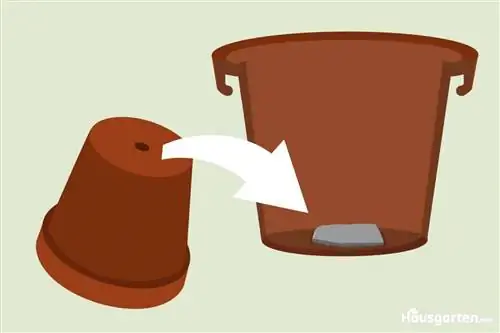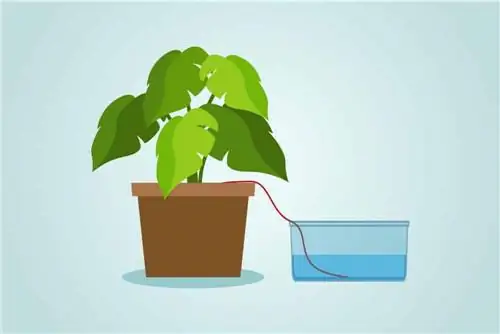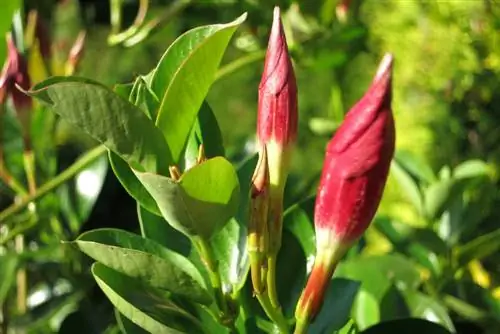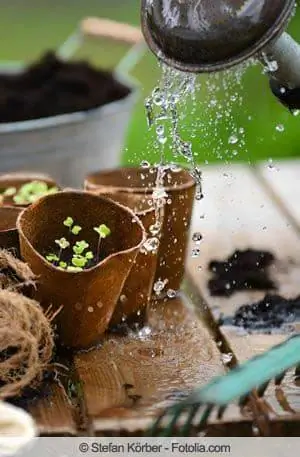- Author admin [email protected].
- Public 2023-12-17 03:39.
- Last modified 2025-01-24 12:45.
Gardeners who enjoy crafting can save themselves expensive Ollas from the hardware store with a clear conscience. Because irrigation with a DIY variant actually offers all the advantages of the original. What follows are detailed instructions for building an Olla yourself, rounded off with a few valuable tips.
The principle of irrigation
The Olla is not a modern invention. Just like the natural material it is made of: clay. In South America, clay pots have been used to store water for centuries. Because clay is porous, it constantly releases small amounts of water into its surroundings. Buried in the ground and regularly filled with water, Ollas ensure an even supply of moisture to the root area of the plants. They are now also available in this country and do their job in garden beds and pots. Building it yourself saves money, but be careful: here too it has to be clay!
Note:
The name Olla comes from Spanish. That’s why the correct pronunciation is “Oja”
Clay pots as a base
Hardly any gardener can make pottery or always has the opportunity to do so. For self-assembly, ready-made clay plant pots are used, each with a hole in the bottom.
The following applies to size and properties:
- Two pots are required per Olla
- no matter whether new or used
- Pots must not be glazed
- Capacity depends on the area to be irrigated
- Rule of thumb: 5-6 l per square meter (both pots added together)
- build several Ollas if necessary
- Use smaller pots for potted plants (space problem)
Tip:
Choose two pots whose diameters differ by about 1 cm. This small difference makes it particularly easy to put the pots together to form an Olla.
Hole sealing
If both pots have holes in the bottom, which is usually the case with terracotta pots, the hole in one pot must be closed. You can use a pottery shard or a flat stone for this.
Glue
The two pots must form a solid unit so that the water only exits through the porous clay surface as intended. Here you have several choices:
- Cement
- Epoxy resin
- Outdoor tile adhesive
Tip:
Sometimes an irrigation system is only needed for a foreseeable period of time. Then it makes sense to glue the pots with real or alternatively vegetable beeswax. The pots can be easily removed and used for their intended purpose.
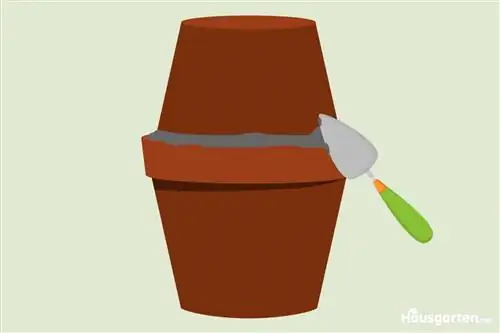
DIY instructions
- Plan your irrigation system, i.e. H. Number and size of ollas. Larger areas are better irrigated with several small, evenly spaced specimens rather than a single large one.
- Gather the materials you need. If necessary, look for used clay pots in good time to minimize costs, for example at a flea market.
- Spread out an old blanket, newspaper or foil as a base.
- Put pots and other materials within easy reach.
- Mix cement or tile adhesive according to instructions. If you are working with wax, melt it until it is viscous.
- Start by gluing the bottom hole, but only for one pot. In the other pot, the hole remains open so that you can fill it with water later using a watering can or hose. If the pots are different sizes, the hole in the larger pot is closed.
- Glue the stone or shard of pottery in place so that the hole is completely sealed. To be on the safe side, check this by adding some water after drying.
- Place the pot with the closed bottom hole so that the large opening faces upwards.
- Place the second pot upside down on top.
- Where the two pots touch, apply sufficient cement or an alternative adhesive. If there are two pots of different sizes, the slightly recessed groove created is filled with the “adhesive material”.
- Let the bonding material harden thoroughly.
- If necessary, test the seal by pouring water and observing the pot for a few hours.
“Commissioning”
The self-construction of this irrigation system is only complete once the clay construction has been buried in the bed to be watered. By the way, this can also be a raised bed. Only the top 4 cm of the Olla should be visible. After the initial filling, it makes sense to check how many days later the filled water will be used up. You can shine a flashlight inside or use a dipstick. The value determined can serve as a guideline for refilling in a timely manner. But remember that consumption can fluctuate over the course of the growing season due to the weather and the size of the plants.
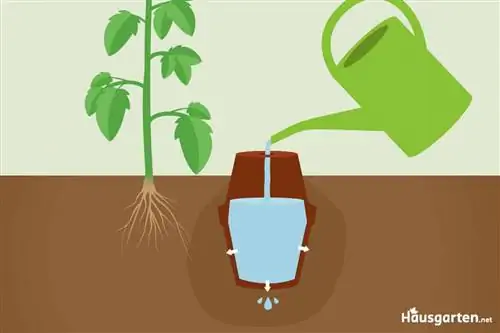
Tip:
So that no dirt or insects can get into the interior of the irrigation system through the filling hole, you should cover it loosely with a piece of shard or a stone.
Ollas are not winterproof
Clay soaks up water, water expands when it freezes. The result: clay pots burst. This irrigation system is therefore not made for local winters. By the way, this not only applies to the DIY version, but also to Ollas purchased in stores.
Tip:
Since watering in winter is rarely or never recommended outdoors, dig up the irrigation system in good time before the first frost and store it in a frost-free room until the temperatures allow it to be used again.

